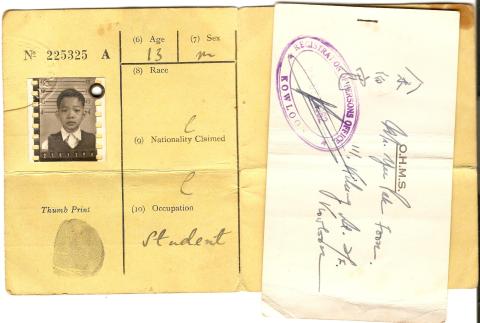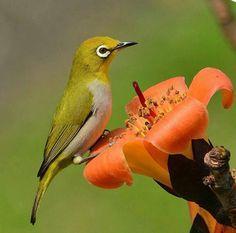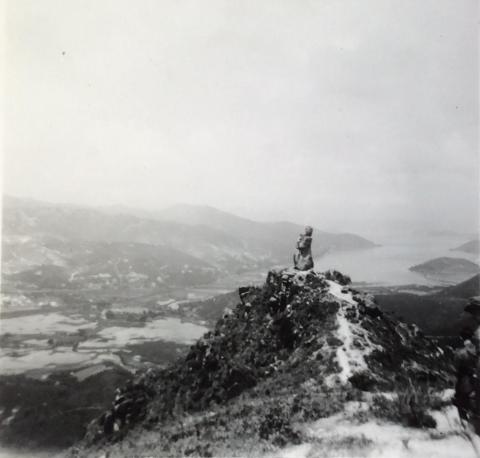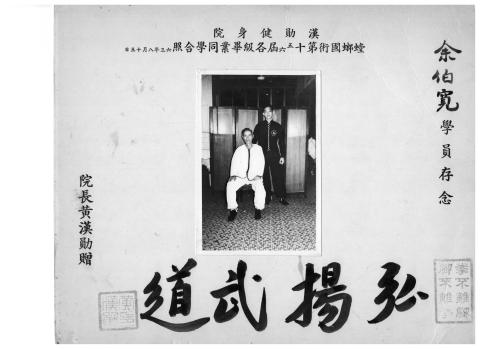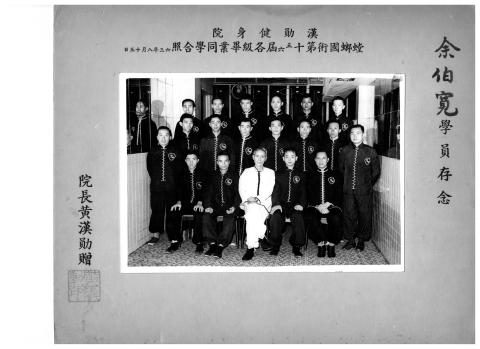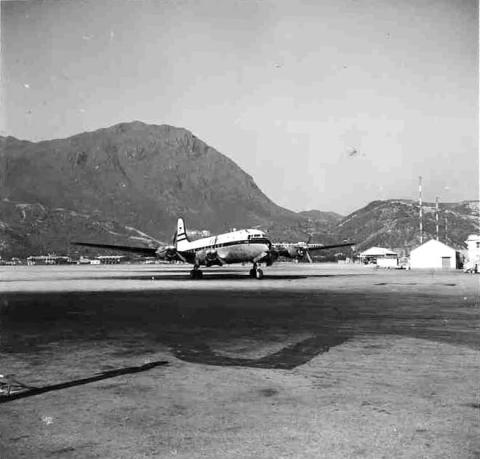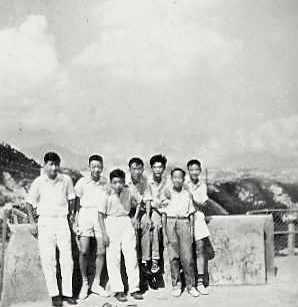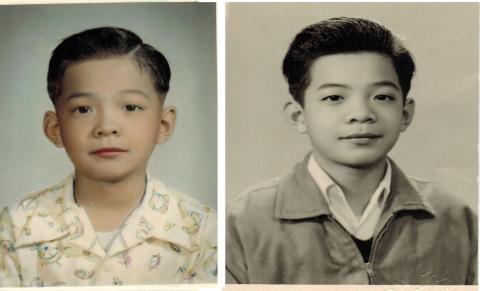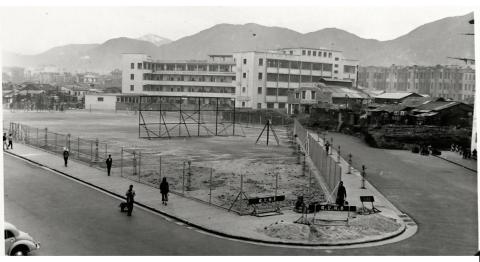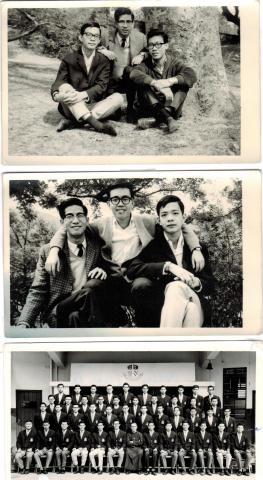In a previous newsletter, Peter Yee described his childhood in Hong Kong up to the year 1955. That was the year he turned 11, and the year his parents and two younger siblings emigrated to Canada. In this issue he continues the story, taking us up to 1964 when he made his own emigration to rejoin his family in Canada.
9.1 Ki Lung Street, 111, 2nd Floor (Level 3)
My daily routine at first remained unchanged, as I still went to Tak Yan College on class days. The big change is that there are now two elderly persons caring for me, and no more family outings like movies, swim at a beach, and visiting my parents' friends. Adult supervision was minimal and no more reminders to read books. Communications with grandparents were infrequent, and when it happened they were short. There was not much in common that we would talk about, and our age gap did not help. Besides, grandpa often came home late from work.
Grandpa Chan worked six days a week year-round except during holidays. The loading and unloading of goods at junks across the street (Connaught Road West) took place almost year-round, so too was he with his brush pen and abacus. Grandma was home all time except when shopping for grocery and visiting friends. Their friends came over occasionally to play Mahjong but she never went out to play Mahjong.
Whenever friends came to play Mahjong, I would sit close next to grandpa watching his every move. They played for fun and the chips were very little money. Each players monitored how the other three played and responded accordingly. That's how I learned to play Mahjong.
The staircases to level 2 and level 3 our flat were straight up. The lower one had 24 risers on account of the high clearance at the street level flat (factory). Above the lower staircase was a small landing where we turned 180 degrees to climb 18 steps to reach home. Without lights and windows, the upper staircase was always in complete darkness. And the handrails were not in the best of shape. Whenever grandpa took me out late at night to fill his hungry stomach after work, I was in front of him as we walked down the stairs, and behind him on our return trip. I figured I would stop him from falling further if he missed a step.
Grandma made sure my clothes fit as I grew. She took me to street vendors on Yu Chau Street near Maple Street Playground. There, I tried to get the right size while grandma discussed the price with the vendor.
One day grandma took me along on her trip to the landlord in Tsim Sha Tsui. The old lady was polite and friendly. She took out a receipt, filled in the blanks, and handed it to grandma as grandma was giving her $55 HK for one month. The rent rarely increased, grandma told me later, they have been living there for a long time. (My mother told me that when we'd first moved to Sham Shui Po in 1949, I could not pronounce correctly our street number, 111. She said I could only utter "knock-knock-knock"!)
Dental and eye care were my shortcomings when I was young. I ate a lot of candies. A small cavity first appeared about the time my parents left Hong Kong, of all places, between the two upper front teeth. Then the cavity got bigger, and bigger. One adult neighbour and good friend asked me to say 漏風 in Cantonese, meaning "leak air" and pronounced "laou fong". The air came out through the cavity. He laughed, no offence, and I laughed too. As the cavity got bigger, I became more self-conscious, and did not want to talk in school unless I had to. When one teacher talked with me, I answered her with my upper lip closed. A smile did not look like a smile. The cavity was too big to hold a filling. The problem was resolved a few years later when my aunt from Guangzhou took me to the dentist 牙醫馬明德 / Dentist Mah Ming Tak on Nathan Road near the Astor Theatre. The $170 HK fee was too much for the partial upper plate, she paid without me asking. I started to show my smile again.
Eye care was another problem. Like the teeth cavity, I kept it to myself. In early 1958, the teacher's writing on the chalk board began to look blurry. I found out I could correct my vision, though by a small amount, by looking through a plastic ruler held at the correct incline or angle. It would be two years after that I got my first prescription glasses. It cost $15 HK examination (very quick) and glasses in plastic frame (heavy), an amount I could afford.
During my time in Hong Kong, we had several typhoons. Before they arrived, I moved our potted plants off the balcony railing to the ground. The clay pots were heavy, and became more manageable as I grew bigger and taller.
Water shortage was a recurring problem. When water rationing was in effect, our building got running water for about four hours beginning in late afternoon. As ground level was a factory and level-2 had several families, we on level-3 had low water pressure especially during cooking time. Grandma Chan was skilful and diplomatic, she set up with the neighbours a schedule for each level to fit in with the four-hour window.
There was a bank run when people got nervous and tried to withdraw their money only to find out they could not, or could withdraw only a small amount. Grandpa and grandma were not affected, as they had very little money in the bank.
In 1963, we got news that the owner was selling to make way for a new and tall building. Grandpa stayed home to meet with the landlord's representative, an aggressive agent. I listened to their conversation about compensation. Grandpa, as always, was polite and soft-spoken. After the man left, he turned to me and said "I think we did alright."
9.2 Time With Grandma Yee
During her time in Hong Kong (1953-1963), Grandma Yee rented a room near my home, and changed places several times. One of of them was on Apliu Street a few shops from the Maple Street playground. The flat's owner also came from Taishan, a requirement since grandma spoke only Taishanese. I visited grandma often and slept there. After learning how to ride a bicycle, I circled repeatedly around the playground's inner perimeter. The next morning, she told me I was riding bicycle in my sleep.
In 1956, a riot broke out. The following day I walked to Cheung Sha Wan Road between Maple and Poplar streets. There, a shop that sold goods from China had been looted and looters were still there gathering the last few remaining items from the floor.
As a result of the riot, the government imposed a curfew. People were ordered to stay indoor, and streets and sidewalks became totally empty. I was on grandma's balcony tall enough to look down to the street when riot police marched by. Her landlady's son was more curious and leaned over the railing. He ignored the police captain's order to move back inside. Within seconds, the captain pulled out his handgun and pointed in the direction of the young man. He quickly backed off.
The following day, grandma had to visit a new relative - the mother of a young woman who was about to marry her grandson from USA. I doubt that she was aware of the seriousness of the situation. Like a caring grandma, she took me along. When the two of us crossed Tai Po Road, we were all alone and no other people on the street in all directions. Several riot police appeared a block away and I could see their guns and shields. They ignored us - an old woman walking slowly on bound feet accompanied by a boy. After the visit, our return walk was just as lonely, but this time, no riot police.
Grandma found out I loved grass jelly. One day she made grass jelly using natural ingredients. Obviously it was the best grass jelly I have ever had. She passed away in 1963.
Source: Harrison Forman
9.3 Hobbies and Favourite Pastime
9.3.1 From Marbles to Kites
My earliest street game began in 1952 corresponding to Primary 3 at Tack Ching School. We boys collected discarded empty cigarette packets. We cut out the front cover which had an attractive picture and folded it to form a small triangle. We placed our triangular pieces on a straight line on the ground and took turns trying to knock them off the line from a distance by flicking our fingers on an empty bottle cap. The caps had candle wax inside made to increase its travel distance and accuracy. If succeeded, the boy retrieved the piece that got knocked off. It was a very affordable game. A few years later, I played another game on sandy ground, this time placing marbles in a circle. The rules of the game were essentially the same. And after that, we added coins to the circle.
I could walk from our level-3 flat to the roof top. In fact, all five staircases in our city block provided unimpeded access from street level to the roof. In those days, it was very rare to see a gate at street level in Sham Shui Po. Starting in 1955, kite-flying was my hobby. On the first day, all attempts to keep the kite in the air ended in failure. Then I found out that to keep the kite from falling, the forward release and pull back of the string must be timed at the right moment as the kite turns. Kites came with different colours decorations and two basic structural designs. I learned how to make glass-power coated string for kite-fighting.
9.3.2 Firecrackers and Fireworks
The opportunity of playing firecrackers, we call it 燒炮仗 in Cantonese, came once a year when we celebrated the Lunar New Year. It was very popular for boys and adult men in the 1950s. The street gutters below my home were covered with red burnt papers. New Year Eve, we called it 年三十晚 (Year 30 night), was the peak of the firecracker activity. The popular brands of firecrackers at that time were the Rooster, Elephant, and Swallow. They all made very loud sound.
Fireworks were not as popular as firecrackers. It seems to me that people wanted a bigger sound than a colourful sight. Every New Year, I spent most of my red pocket money on firecrackers.
9.3.3 Children's Pictorial Story Books
While reading school books was not my interest, comic books were. We called them 連還圖 or 公仔書. They contain a short story with hand-drawn pictures on every page, and few words on the outer margin as the story is already partly given by the illustrations. Across from Grandma's room on Apliu Street, there was a book stand operated by a man who I believe came from northeastern China. He was a quiet man. I spent a lot of time there reading his books. When I gave him ten cents, he gave me a tiny piece of cardboard paper with a stamp mark on it, which I used to sign out the books. He supplied several small wooden stools for his young customers.
My aunt (father's older sister) in Guangzhou found out I loved reading these story books. She was a very wise person and well educated. Being concerned that the books would have a bad influence on me, on her next visit to Hong Kong she gifted me a small story book. Like other books, it too had a story and hand-drawn pictures, but there was one difference. It was a condensed and simplified version of Chapter 35 in 三國演義 / Romance of the Three Kingdoms, a historical novel covering the 169-280 AD warring period among the three kingdoms, namely the north led by 曹操 / Cao Cao, in the west 劉備 / Liu Bei, and in the east 孫權 / Sun Quan.
The story was about Liu Bei's first military and political adviser named 單福. Before they first met, Liu was travelling one day when he saw a boy riding an ox and making music with his短笛 / short flute. Liu stopped, and the boy and his music stopped too, and next came their conversations:
Boy: Are you not Liu Bei, the general who defeated 黃巾 / Yellow Turbans (Rebellion)?
Liu: Little village boy, how do you know my name?"
Boy: I don't know, but when people come to visit, my teacher always talks about Liu Bei, who stands seven feet five inches, his hands can reach below the knees while standing, eyes placed such that they can see the ears. One current hero! What are you thinking about now?"
Liu: Who is your teacher?
(The boy answered his question)Liu: Yes, I am Liu Bei. Take me to your teacher.
When they met, the teacher agreed to serve Liu in his political and more importantly his military campaign. His strategy helped Liu win one battle. Shortly after that, he decided to travel north to join with his mother who, according to a fake letter sent to him, had been taken hostage by Liu's opponent Cao Cao. At the end of their farewell moment, he advised Liu to visit another advisor, later known as諸葛亮 / Zhuge Liang, Liu Bei's brilliant military and political strategist and a character admired by readers of the novel.
Rural and palace settings, political and military strategies, field battles, master-and-servant interaction, mother-and-son relationships and their belief, all put together to make one romantic read! I loved reading it, and next Chapter 35 in the original novel, and after that, the entire novel. There were words for places and names that I didn't learn, so I looked at the word as a picture, and assigned it a sound that best matched it.
The chapter recounting the debate between Zhuge Liang and Sun Quan's advisors was part of the Chinese literature taught in my Form 2 at St. Francis Xavier's College.
I have very few regrets in my life, and one was related to the novel. One day Grandpa Chan found out I had been reading the novel. He smiled and said "That's good. Have you read 諸葛亮火燒新野?". It was about one of Zhuge Liang's early battles where he directed soldiers to burn a place as part of his strategy to distract the opposing army. I knocked my head several times, but said nothing to grandpa. Here, we have something in common and I miss the opportunity to extend our conversation.
9.3.4 From Radio to Records
In the early 1950s, radio stations in Hong Kong played Chinese and Western music. I listened to both. In my early years, we listened to Chinese Cantonese operatic songs, solo and duets some of them my favourite - 長片粵曲 and 時代曲 / Long Cantonese and contemporary songs. To receive a good broadcast signal, some people ran their antenna to the top of the roof. There were posts and wires making some rooftops not an ideal place to fly kites.
Our radio was placed about five feet above the floor. So when the grandma played Mahjong with visitors and I did not want to miss the program, I stood on a wooden stool to have my ears close to the radio. One time, my classmate made me a crystal radio receiver. It used only the power of the received radio signal to produce sound. It did not need battery. I was thrilled when he demonstrated it in his home. When I got home, it did not work. I kept buying replacement crystal thinking they were defective, but still no sound. Then I realized there were too much obstructions and concrete walls between our flat and the radio stations.
It was popular for people to call in to radio stations asking them to play a song "to dedicate to" someone. One time I heard some George dedicated to Peter "Broken Hearted Melody" sung by SarahVaughan. I don't think it was a coincidence since I told George two days earlier I liked the song. When radio stations played Pat Boone's "April Love", I knew it was spring time. Besides the vocal music, our generation liked instrumental music from Henry Mancini, Lawrence Welk and Billy Vaughn "... And His Orchestra." I liked Mantovani and collected several of his LP's, and an Acker Bilk Long Play containing his famous song "Stranger on the Shore". Bilk's LP cover had a beautiful drawing of an English countryside with a quiet little creek.
I followed one radio story-reading program. Once a week Chan Po Wai read out a part of the Chinese novel 七俠五義 / Seven Heroes and Five Gallants. His program started with a short music note sung by a rooster. It took him about a year to read the entire novel.
We also listened to Western music in tea rooms. They had jukeboxes for you to insert your money and make your choice. Those played often were The Ventures, The Shadows, North to Alaska, Telstar, and other popular songs of the 1950s. My father had a 78 record theme song from the movie "High Noon".
9.3.5 Bird Companions
At the service lane on the west side of Shek Kip Mei Street between Yu Chau and Apliu streets, there was a man in his 40s operating a small bird shop. His set up consisted of a few long bamboo sticks fastened to a wall, and about 1~2 dozen birds and their cages, most of them green singing finches which I heard were bred in farms in South Africa. Another kind he was selling was 相思 / Japanese White-Eyes. Later on, more exotic birds showed up. I often stopped and talked with him, as he was friendly. I don't think he had a family. He slept at night with his birds. By 1962, he managed to close in his shop with wooden panels making it more home-like and out of the cold winter. His was a very small cramped place.
Source: Pinterest.com
My grandparents did not object to me keeping birds. They thought a bird companion would do me good. I once also kept a Myna bird. Some times, I let the birds out of their cages. This required first closing all the windows. They liked perching on our peach tree during the Lunar New Year.
9.3.6 Hiking And Exploring
The first time I hiked to Lion Rock and Amah Rock was in 1957, then a few more times after that. In 1957, the approach trail to Amah Rock was fairly barren with low vegetation. One time, my classmate and I descended Amah Rock on her left side - the side facing Shatin. There, the slope was very steep and covered with many small rocks. It was so steep that standing still on them was almost impossible.
Source: Bryan Panter
To hike from Kowloon Tong to Shatin, one needed proper shoes. For me, there was no such need. I stayed with my Japanese outdoor slippers which were amazingly tough. They never failed. On the north slope of Lion Rock, my classmate showed me where to find an interesting plant with furry roots. We pulled out a few and took them home. It was believed that they would stop bleeding from a cut. Harvesting the plants was likely not allowed, and such regulations, if existed, never entered our mind.
Streams and water always interested me. On the north side of Cornwall Road and just west of the Canton-Kowloon train tunnel, there was a small reservoir, likely some kind of storm catchment basin. It actually had two basins in series. I swam there several times with guppies by my side. Sadly, child drowning occurred occasionally. Less dangerous places were the stream under Boundary Street that flowed to the nullah, and the one beneath Clear Water Bay Road just below Good Hope School.
9.3.7 Martial Arts
In 1962, I started taking Martial Arts lessons taught by Wong Hon Fun 黃漢勛, after being introduced to him by my bird friend Ho Ying Gwai who was already his student. In Cantonese dialect, we addressed him 師傅 / Sifu a title for a skilful person or a master. Sifu taught Praying Mantis, a style of Martial Arts which has its origin in China. The lessons I took were not designed purely for fighting purposes, for some body, hand, and feet movements act as connector or transition between offensive and defensive movements. It was a pleasure to watch someone who displays a lesson he has perfected, similar to reciting a poem you have memorized and you also put your best effort and feeling into it. The lessons took place in the early evening once a week, and the fee was $15 HK a month.
Because the students started their training at different times, they were at different levels (or progress). This required Sifu to teach us on a one-to-one basis. On my first day, he showed me a short series of body, hand and feet movements. He would call out gently the name of each movement. He wanted me to remember their names because some of them would appear in subsequent lessons.
At the beginning, I thought one movement was odd. It required you to stand with knees bent, your back straight, and imagining you are sitting on a chair. He also taught me how to pose using my five fingers, a pose identical to the arm of a praying mantis about to strike. He would then ask me to repeat what he had demonstrated, and corrected me when needed. I would then repeat the short series I just learned, over and over again.
The second week, while I was watching other students practising, Sifu tapped on my shoulder and continued to teach me where we left off the previous week. I did not need to remind him, he knew, by memory or by pen I could not confirm which. After a month or so, I completed learning one lesson. In subsequent weeks, I would practise all lessons learned, and waited for Sifu to tap on my shoulder. He was a dedicated teacher, kind and treated all his students with respect. His students ranged in age from mid-teens to late 40s.
9.4 Street and Playground Bullies
I never encountered a bully in my schooling. However, I had the misfortune of running into, or rather them coming at me. The events took place in three consecutive years.
In late 1955, I was playing goalie and my Tak Yan College Primary 6 classmate the shooter at MacPherson Playground in Mong Kok. Behind me was Shantung Street and a chain-link fence. Two boys about my age walked by and they started to taunt me, saying that I was lucky to attend school and play. I turned my head and got a glimpse of them. As I turned to focus on the ball, I heard someone behind spitting and next something landed on my neck. The smell was bad. I was shock, too afraid to look at them a second time.
In 1956, I was playing with sand at Maple Street Playground when three boys walked up to me. One boy tried to destroy what I had built so I tried to stop him. By this time, a second boy was already behind me and he hit me on the back with a stick. With two boys my age and size, and their leader older and taller, fighting back never entered my mind. This was a more frightening situation than the first. I hurriedly ran back to my grandma's place and did not say anything. For a while after the incident, I dreaded using Maple Street to visit her.
In the summer of 1957, I attended an evening English class at the St. Francis of Assisi's Primary School. The school and the church were located on Shek Kip Mei Street next to the former shanty town which subsequently became 7-storey resettlement area following the 1953 fire. One evening my classmates and I were talking at the entrance when three boys about my age showed up. One boy wanted to start a fight with me. It was one shocking surprise, and I ignored him. When he persisted, one of my classmates stepped in and said "I will fight you." The aggressors backed down and left. I never forget that Gan Wei Ho came to my defence. After the incident, I carried a pocket knife (given by father) when I went to attend class there. It was likely of no use because I would never think of taking it out. When children bring knives to school, I would suggest they are more likely a victim than a bully.
9.5 Schooling
Primary 6 (1955-1956), Tak Yan College 德仁書院 (Incomplete)
In September 1955, I started Primary 6 at Tak Yan College. It did not turn out well. The class subjects were getting more difficult, and I could not get help with my homework. After my parents left Hong Kong, I felt lonely and helpless. After the bullying incident, I dreaded going to school every morning. One cold and damp morning in late 1955, I decided to stay in bed and not to go to school anymore.
I began to play in the streets, some times alone and other times with street friends. By this time, our roof top was occupied by refugees from the mainland. It was like a small shanty town. Flying kites was no longer possible, but I managed to befriend the children my age up there.
The level 4 above my flat was a shoe factory with workers from the mainland, and we became friends too. They were men in their 20s and remarkably well-mannered. Like the welder below me at street level, they spoke a dialect somewhere between Taishanese and Cantonese but closer to the former. They called me 小個 / The Little One. For leisure after work, they set up a ping-pong table on the roof and I was one of their regular visitors. The retail shop, called 九龍鞋廠/ Kowloon Shoes was on Boundary Street across from my home.
In a recount told by my sister years later, it took grandma several weeks to find out I had dropped out of school. Grandma decided not to inform grandpa for fear that the news would upset him. As grandpa was fully occupied with his work, he did not notice the change.
Primary 6 (1957) School Name Unknown (Incomplete)
In early 1957, grandma placed me in one of the roof-top schools in Shek Kip Mei. All subjects were taught in Chinese, and the class size was small. I quit that school after attending it for several weeks. There was no compelling reason to drop out except for lack of interest and self-discipline.
English Night Class (summer 1957) at St. Francis of Assisi Church 玫瑰夜校
華姐 (Big Sister Wah) was one of Grandma Chan's congregation friends at the St. Francis of Assisi Church. At the request of grandma, she enrolled me in Good Hope Anglo-Chinese School the same school she was attending. Since it would be all-English, to prepare for it, she also placed me in a night English class held twice a week at the Church.
The class was designed to teach students to speak and write English at a basic level so we could converse with friends and in workplace. Grammar was important, but the school wanted a proper balance between speaking and grammar.
I made friends with classmates during recess. The workers were friendly and they organized a hiking trip to Shatin - my first of several trips.
Primary 5 - Primary 6 (1957-1959), Good Hope Anglo-Chinese School德望學校
In September 1957, I resumed full-time schooling. In 2016, the school invited her past students including me to write about our memories of the school on the occasion of "Anchor of the World II for the Diamond Jubilee" celebration. My memories of the school are best expressed in the submission I gave the school, repeated below with some minor edits:
"Sixty-one years ago (1955), this boy dropped out of school and started to play in the streets. Life was fun at first then gradually became aimless. A year and a half later, a family friend enrolled me in Good Hope.
The school was built a few years earlier on the side of a hill facing Kai Tak Airport. The scenery and tranquility were unmatched. There were no other buildings nearby. Much of Clear Water Bay Road was still undeveloped and wooden houses on large lots dotted along a short stretch of the road close to the airport. Traffic on the road was very light then, and I saw only a few cars during my walk to school. From the school, I could see the airport and planes taking off, and was awed by the sight of Kowloon Peak.
Good Hope provided me an excellent environment to learn. I noticed the class size, the quality text books, and soon her dedicated teachers. My teacher Miss Chan* (1957) was kind and patient with me noting that I needed help to catch up. I didn’t have an English first name and neither my grandma nor I could think of one. So during class, Miss Chan asked if I would like to be called Peter to which I promptly agreed. With the help from teachers and my extra effort, I managed to catch up.
The playful nature in me remained strong. After school, we boys sometimes walked downhill to the airport where we switched to city bus. The walk uphill was just as enjoying and George Leung and I arrived very early at the foothill to start our walk. So quiet and free, the whole country side was there for us to explore. The walk through 維記牛奶 / Kowloon Dairy pasture was unforgettable.
After P5, most of the boys went to other schools. Henry Butt and I missed the opportunity to change so we were the only two boys in P6. Being out-numbered by girls, one can feel lonely at times. In those days and at our age, girls and boys seldom talked with each other and I was too shy to start a conversation. Looking back, the extra year with Good Hope enabled me to stay another year with the finest school I have ever attended.
In my P6 final report card, it reads “Promoted to Form 1 on condition leaving”. The message was expected. It was a moment of pride but also a sense of sadness. One teacher worried about Henry and me so she wrote a letter of recommendation to St. Francis Xavier’s College.
After leaving Good Hope, one night I took a city bus to the foothill to see my beloved school one more time. From the bus, I could see her lit up cross. Since then, whenever I think of that sight, these words come to mind - "The school that has given me more than hope."
* Two weeks after class started, Miss Chan noticed one problem I had. So during a recess on a Monday, she came to me asking if I knew the word "remind". I replied "No". She asked me to look up its meaning in a dictionary, which I did and reported back to her later that day. She said to me with a soft voice - "Peter, can you remind me this coming Wednesday to make an announcement to the class? "Yes, Miss Chan!" That was the first one-on-one assistance I have ever had in all my primary schools. Came Wednesday morning, I reminded her and got a "Thank you!" that came with a smile. One word, she has restored my confidence!
Seven different schools to complete six primary grades, if not a record in Hong Kong, I think I am close. They were part of my story, no regret, no shame. Sometimes, one needs failure to achieve success. I think there is a saying for this in every language.
In 1957 when I entered Primary 5, the surroundings looked very similar to this photo including the erosion along the edge of the road.
Source: Good Hope School Year Book
From the school, we could see airplanes taking off from the airport. From Clear Water Bay Road (name in that period of time) we could see the school, and at night its lit up cross.
From left: Henry Butt, Paul Wu, Peter Yee, George Leung, Michael Chau, Henry Tong, David Wong. Not in photo is Ronald Tam.
This creek flows under Clear Water Bay Road, about 2 minutes walk downhill from school. It is about mid way between the current Po Leung Kuk Centenary School and Fung Chak House.
Form 1 - Form 5 (1959-1964) St. Francis Xavier's College / 聖芳濟書院
The building housing St. Francis Xavier's College was four years old when I entered Form 1 in 1959. The classrooms were on the first three levels and the Catholic Brothers lived in Level-4. Connected to the building was a covered area with a canteen operated by a Chinese family, and several ping-pong tables. There was a small open area on the southeast corner enough to park two cars and few Vespa mopeds. Along the south wall there was a covered area for bicycles.
Middle: John Chan, Dominic Fong and Peter Bottom: Class with Brother Leo. Peter on front row third from right.
The college had five Form 1 classes each about 45 students. By the time I reached Form 5, there were three classes. Along the way, some including my friends left. One Form 1 friend surname Lum was good at playing soccer. His parents operated a roadside stall selling fruits two blocks west of the school. When I reached Form 2, he did not show up. I went to their stall where he, standing beside his mother, told me that he forgot to register to continue his schooling. I always suspect the reason was about tuition fees.
We had very good and dedicated teachers both Brothers and hired teachers. They were approachable in class and during recess. The subjects were taught in English except one for Chinese literature at lower forms. Mr. Wong our physical education teacher came from Tack Ching Primary School where he was also my teacher. In his Form 1 session, he led us on a run around, and next stretch. After that, he threw out a few soccer balls for us to play. Starting in Form 2, it was only stretch and run and no fun. I guess the sight and noise were too distracting to the classes in process.
While in Form 5, some classmates were talking about final general exams. In early 1964, I saw two students studying and holding notes in their hand, of all places and times, in the playground during recess. That got me nervous!
My five years at SFX was the longest span of all the schools I attended. It was a period where I transitioned from boy to teen. I left holding dear the memories of the Brothers, teachers, and classmates.
Thanks again to Peter for his open and honest sharing of his memories of his early years. To find out what happened next, please continue reading:
People's memories of their lives in Hong Kong are a very valuable part of Gwulo, helping to bring the site's photos, facts, and figures to life. We have a selection of other diaries and memoirs available to explore: https://gwulo.com/list-of-diaries?order=field_book_doc_date&sort=asc
If you can add any more, your contribution will be very welcome. An easy way to share a story is to post it to the forum: https://gwulo.com/node/add/forum/2

